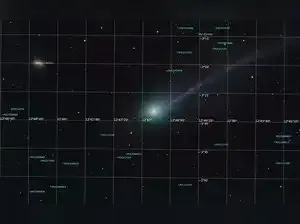What is HiRISE and why is everyone waiting for 3I/ATLAS images captured by it has become a key question for space watchers as NASA prepares to release new data. The HiRISE camera on the Mars Reconnaissance Orbiter recorded rare 3I/ATLAS images during the comet’s close pass near Mars. These HiRISE 3I/ATLAS images may help researchers study the interstellar object, understand its long journey, and examine material that formed outside our solar system. Interest has increased because the comet is moving toward its closest point to Earth, and many expect the upcoming NASA release to offer the clearest view yet.
These new HiRISE 3I/ATLAS images are expected to offer the highest resolution view of the comet. Reports suggest they may provide clearer detail than the Hubble Space Telescope images captured in July. This has created demand among researchers and the public who want to understand the comet’s structure, material, and possible origin.
Depending on its origin, 3I/ATLAS may be more than 7 billion years old. This means the comet could be older than the Sun by more than 3 billion years. This raises interest because its material has experienced long exposure to cosmic rays in interstellar space. That exposure changed its surface and interior. Tracking the material may provide clues about conditions in early regions of the galaxy.
Observations indicate the comet is around 7 miles or 11 kilometers wide. It is moving at more than 130,000 mph or 210,000 km/h. The comet passed perihelion two weeks ago. It will reach its closest point to Earth on December 19.
The comet has several unusual properties. Its chemical composition and size are key points of study. Some radio signals recorded from the comet match signals from regular comets. These details have led to online speculation that 3I/ATLAS could be an alien probe. Scientists say this is not true. Even so, the comet remains important because it may help understand star formation, interstellar matter, and early galactic environments.
These may be the best images of the comet so far. They may help researchers understand the comet’s material, its origin, and the changes caused by its long travel through interstellar space. The HiRISE camera is expected to offer better resolution than the Hubble images from July 21, 2025.
3I/ATLAS continues to brighten as it moves through the solar system. NASA scientists are preparing to study the coma, the jets, and the structure of the tail recorded during this period.
Another image was posted on November 17, 2025 by Francois Kugel. It combines 22 exposures of 30 seconds each using a 0.4-meter telescope. These new images offer interim views while the community waits for the official NASA HiRISE release.
FAQs
1. Why are HiRISE images of 3I/ATLAS important?
HiRISE images may show the comet’s structure, tail pattern, and material in more detail. This may help researchers understand the comet’s interstellar origin and its travel path through the solar system.
2. When will NASA release the HiRISE 3I/ATLAS images?
NASA has not given a confirmed date. Reports suggest the release may come early this week now that the government shutdown has ended and processing work has resumed.
What is HiRISE and why is everyone waiting for 3I/ATLAS images captured by it?
What is HiRISE and why is everyone waiting for 3I/ATLAS images captured by it is now a major space topic because NASA has not yet released the new set of comet images taken by the High Resolution Imaging Science Experiment camera. The HiRISE camera is mounted on NASA’s Mars Reconnaissance Orbiter, which has been in orbit around Mars since 2006. Its main work is to study the surface of Mars and capture high-resolution images for research. During early October, HiRISE captured rare images of comet 3I/ATLAS during its passage close to Mars.These new HiRISE 3I/ATLAS images are expected to offer the highest resolution view of the comet. Reports suggest they may provide clearer detail than the Hubble Space Telescope images captured in July. This has created demand among researchers and the public who want to understand the comet’s structure, material, and possible origin.
Why 3I/ATLAS matters in space research?
3I/ATLAS is the third interstellar object ever identified in our solar system. This makes it important because it does not originate from our solar system. It came from a distant region of the Milky Way. The exact source of the comet is not known. Scientists are not sure if it came from the thin disk of the galaxy or from the thick disk.Depending on its origin, 3I/ATLAS may be more than 7 billion years old. This means the comet could be older than the Sun by more than 3 billion years. This raises interest because its material has experienced long exposure to cosmic rays in interstellar space. That exposure changed its surface and interior. Tracking the material may provide clues about conditions in early regions of the galaxy.
Observations indicate the comet is around 7 miles or 11 kilometers wide. It is moving at more than 130,000 mph or 210,000 km/h. The comet passed perihelion two weeks ago. It will reach its closest point to Earth on December 19.
The comet has several unusual properties. Its chemical composition and size are key points of study. Some radio signals recorded from the comet match signals from regular comets. These details have led to online speculation that 3I/ATLAS could be an alien probe. Scientists say this is not true. Even so, the comet remains important because it may help understand star formation, interstellar matter, and early galactic environments.
NASA’s expected release of HiRISE 3I/ATLAS images
NASA has not confirmed the exact release date for the HiRISE comet images. Reports suggest the release may come early this week. A recent U.S. government shutdown caused delays. Now that the shutdown has ended, the images are expected soon.These may be the best images of the comet so far. They may help researchers understand the comet’s material, its origin, and the changes caused by its long travel through interstellar space. The HiRISE camera is expected to offer better resolution than the Hubble images from July 21, 2025.
3I/ATLAS continues to brighten as it moves through the solar system. NASA scientists are preparing to study the coma, the jets, and the structure of the tail recorded during this period.
New images from astrophotographers
A new image of 3I/ATLAS was captured by astrophotographer Satoru Murata. It combines 24 exposures of 60 seconds each using a 0.2-meter telescope in New Mexico on November 16, 2025. The image shows different jets moving toward and away from the Sun, including an anti-tail and a long, narrow tail.Another image was posted on November 17, 2025 by Francois Kugel. It combines 22 exposures of 30 seconds each using a 0.4-meter telescope. These new images offer interim views while the community waits for the official NASA HiRISE release.
FAQs
1. Why are HiRISE images of 3I/ATLAS important?
HiRISE images may show the comet’s structure, tail pattern, and material in more detail. This may help researchers understand the comet’s interstellar origin and its travel path through the solar system.
2. When will NASA release the HiRISE 3I/ATLAS images?
NASA has not given a confirmed date. Reports suggest the release may come early this week now that the government shutdown has ended and processing work has resumed.








